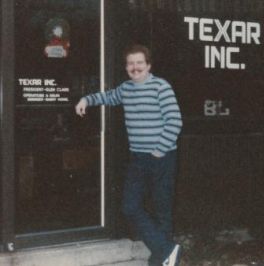The EMP Will Be Worse Than You Think

[August 2017] This is Part One of a five-part series on how to deal with an EMP event in a radio broadcast setting.
Ten years before TEXAR was incorporated, Lyndon Johnson decided that I would look good in a green uniform and carrying an M-16 rifle.
One of the places that the Army sent me was to the Army’s Signal School at Fort Gordon, Georgia.
Six years after TEXAR was sold, I was hired by FEMA as a consultant on electromagnetic hardening of radio transmission plants against hostile foreign action. A blending of these two experiences yields an understanding of how an EMP is most likely to be used by an antagonist.
There are many facts to be considered when planning for the possibility of an EMP attack. But two stand out above all others:
- Nowhere is it written that an EMP will be a one-time event.
- AC power distribution transformers are not an off-the-shelf item.
Reality is Counter-Intuitive
Hidden behind those two short sentences is a powerful reality that every broadcast engineer should grasp, from the engineer responsible for an FM on a 2,000-foot tower in Atlanta to the one responsible for a kilowatt daytimer in Orem, Utah.
These implications are counter-intuitive to a lot of what broadcasters have come to regard as normal.
Broadcasters instinctively know that it is very expensive to not be on the air. Every minute of off-air time is a minute of inventory that is gone and cannot be recovered. If the station is “sold out,” that means lost money that cannot be rescheduled.
But the more expensive way that off-air time hurts stations is in loss of audience. Listeners are an impatient lot and, if the music or the talk show disappears, listeners start hitting the scan button to see what else is available. Studies have shown that a station can lose more than half of their audience in less than a minute – and it can take weeks to recover.
This logic is so ingrained in us broadcasters that we do not even go through the steps in our minds of “why” we want to get back on the air as soon as possible. We just know that, in a peacetime environment, getting back on the air quickly is the right course of action.
But, in an EMP scenario, getting back on the air quickly may be exactly the wrong thing to do.
Why Moving Fast is Wrong
The whole purpose of an EMP attack is to attrit the enemy’s electronic systems and cause havoc in his ability to conduct his daily affairs.
Critical electronic systems often have back-up systems which can be switched on-line quickly if the primary system fails. Systems which are extremely critical often have a tertiary system which further improves the system’s survivability.
But any hostile actor with the know-how to build an EMP weapon and to put it in a suborbital trajectory knows this.
Every piece of military hardware comes with a manual for the most effective way to use it. Planners believe that, if the hostilities are not ended in a shorter time period, a second EMP weapon is likely to follow a first weapon, with a time between detonations of several days. The purpose of the second EMP weapon is to take out the back-up systems which have been moved from back-up status to in-use status.
Understanding the Differences
Broadcasters are accustomed to dealing with things like lightning damage.
Similar to an EMP, lightning is likely to leave carbon tracking on some parts which will prevent that system from working until repaired or replaced. But Mother Nature does not actively conspire against us. An adversary who has already detonated one EMP weapon is very much conspiring against you, trying to make the disruption to infrastructure as great as is possible.
As a result, what is the correct move for a lightning strike could be exactly the wrong move for an EMP event.
If an EMP Happens
Broadcasters should comply with all legal directives from municipal and civil authorities.
But do not be in an instinctive headlong rush to return to the air if that act requires you to expose your backup systems to a possible second EMP.
It is unlikely that a second EMP would follow the first by only a few hours. The maximum number of secondary systems would not all be on-line by then and some would therefore survive. On the other end, very few planners anticipate that any hostilities including nuclear devices will last more than a week.
There is no magic number for how long the adversary should wait between EMP events to create maximum impact. But most planners seem to favor a number between two and four days.
Suppress the Inclination
After an EMP attack, broadcasters should suppress the instinctive urge to return to the air immediately if it requires exposing your back-up system to a second EMP device.
The exception is if you are part of an established rebroadcast network where you are a link in a chain. In that event, you should do whatever the plan requires.
If you are responsible for a cluster of stations, the best course of action might be to return to the air with one station while holding another station in reserve, off the air.
Not Understanding the Danger
The popular media, including several feature-length movies, show scenes with hundreds of cars immobile along the interstate, made inoperable by an EMP.
Showing thousands of people in angst because they cannot get home presents a viewer stress that keeps the audience interested. And while hundreds of crippled cars is a real possibility, the longer-term effects are actually the more dangerous, when compared with the inability to get home on one particular night.
We are talking about the vulnerability of the electrical distribution system.
The Power Distribution System
The electric utility system that makes 120 VAC appear in the wall outlet next to your desk consists of two parts:
- power generation and
- power distribution
The utility makes the power in a small number of facilities and then distributes it with a network that forks repeatedly, like the branches of a tree. Close to the generators are transformers larger than a transit bus. Hanging on wooden poles close to the consumer are transformers, called “pole pigs,” which are the size of small oil drums.
Between these two endpoints, there are usually two or more layers of intermediate-sized transformers.
A large percentage of these transformers were manufactured in one of two places. General Electric made most of their transformers in a giant factory in Schenectady, New York, near Albany. After 1924, Westinghouse made most of their transformers in a 14-city-block long factory at Sharon, Pennsylvania.

A large percentage of the transformers installed in the US during the electrification of America were manufactured by either Westinghouse or General Electric. This 14-city-block long Westinghouse factory, located in Sharon, Pennsylvania, produced from approximately 1924 to 1974. The building is so large that there is a railroad track that runs the entire length, inside the building.
This progression of events at the end of the 19th century is well told in a book by Jill Jonnes, Empires of Light: Edison, Tesla, Westing-house, and the Race to Electrify the World
Transformers Are Crucial
Unlike most residential appliances, like a refrigerator, a washing machine or a sump pump, which may have an average service life of a decade, AC power distribution transformers have a service life of many decades.
It is not unusual for 60-year-old hardware to remain in service today. And a large fraction of those that have been replaced were due to PCB oil issues, not wearing out.
Unlike a flat-screen television, a smartphone or a desktop computer, power distribution transformers do not have built-in obsolescence. And, unlike other consumer items, which are intended to become obsolete quickly, the economics of having a work crew replace a transformer makes the best transformer design one that lasts and lasts.
Keeping Up With Demand
In the early 1900s, America was in the explosive phase of electrification.
Every city and every small town wanted to have electricity and they wanted it “now.” Manufacturers were hard-pressed to keep up with demand. A second surge in demand for transformers appeared immediately after the end of World War 2. “Baby boomers” built housing developments and cul-de-sac housing plans on almost every piece of farmland near a big city.
These housing developments required more transformers.
But the “rat in the belly of the snake” has passed. The baby boomers built their housing developments more than 50 years ago. The demand for new transformers today is less than it was through the decade of the 1950s. And transformers which fail in service today, usually from lightning damage, can often be disassembled, refurbished and put back into service.
So the ability to produce new transformers quickly is not one that America has maintained.
In fact, no company maintains an industrial capability to satisfy a demand that “might happen.” Corporations pay to put new roofs on buildings and pay taxes on real estate for a factory that serves an ongoing, demonstrated demand. The production capability to make transformers in the US today is a small percentage of what it was in the 1950s and the 1960s.
… And Without Transformers
Which brings us to the most important single point in this whole article:
If an EMP takes out 50% of the in-use transformers between Savannah, Georgia and Carbondale, Illinois, how long will it take to return AC power to its pre-EMP levels?
The surprising but truthful answer is “probably more than a year.”
Tens of thousands of cars that will not run will certainly be an issue after an EMP. Yet, having no power to run refrigeration at home, no power to run the freezer cases at the supermarket, no power to run the pumps at the gas stations, no power to run sump pumps, no power to run elevators and HVAC in high-rise buildings, no power to run traffic lights, and no power to run cell towers will turn daily life upside down in ways that most civilians have not considered.
Do Not Expect AC Power Mains to Come Back Within a Month
Some facilities used on a daily basis by civilians have local generation, also known as back-up power.
Usually this power comes in the form of diesel generators. Cell towers, radio stations, hospitals, airport runway lighting. and 911 call centers usually have generators which will start automatically if the commercial Mains fall to zero Volts.
However, these systems are usually designed to operate only for periods ranging from several hours to several days. The local fuel tanks are of a size that will run the generators for those brief periods. But, if the commercials Mains do not return for a year, each critical generator will have to be supported with frequent resupply of diesel fuel.
More than a year without commercial power would create a disruption of American life that has never been seen before. Is that number flexible?
A Critical Backlog
If the federal government were to assign resources to the problem on a scale comparable to the Manhattan Project, it could not hurt.
Nevertheless, some tasks do not compress very well – and transformers are not an off-the-shelf item. America’s present capacity to produce new transformers is a trickle of what it was in the 1950s and the 1960s, and they are not stored in quantity in warehouses – historically, transformers for new construction are made-to-order.
There are two very thinly-stocked reservoirs of hardware in the present system:
- utility companies generally stock a few units in each county, sufficient to allow for rapid repairs after a large storm or a tornado, and
- the hardware vendors often stock a few of their most common sizes. This is not done to aid recovery after an “event.” These units held at the hardware vendor are an artifact of the fact that manufacturing one unit at a time is inefficient. If two units are sold from a batch of six units manufactured, the other four units are a buffer until the next batch is manufactured.
But these two thin reservoirs will be a teaspoon in a bucket in the event of a significant EMP event.
Slow Ramp Up
How do you mass produce a large number of transformers in a brief period?
That is the problem. You just cannot do it.
At first look, a utility distribution transformer is quite simple in concept. It usually consists of three main parts:
- an outer containment or shell, almost always made of steel, which might be cylindrical or rectangular
- an inner “core” which consists of two or more windings placed around a laminated steel core, usually made of high silicon steel, and
- many gallons of cooling oil which transfer heat from the core to the shell.
Some transformers may also include a “tap-changer” which adjusts the device to increasing and decreasing loads.
Cooling oil is a simple commodity. You simply pour it out of a barrel. The shell can be cut from flat sheet steel by a plasma cutter. The plasma cutter, which is driven from a CNC file made on AutoCAD, can turn out even the most complex shells in minutes.
The Bottleneck
The core is the bottleneck. Seldom should a sentence be repeated. But, as this is the essence of the matter, it bears repeating.
The core is the bottleneck when manufacturing transformers.
The core contains only three components, steel, copper and insulation. But the geometry is complex, bordering on impossible, and looking somewhat like an Escher drawing. The required core geometry, unlike PC board assembly, does not lend itself well to high-speed automation.

Two coil winders engaged in the painstaking task of fabricating the heart of a transformer. The right end of the cylinder is supported by a free-running bearing. The left end of the cylinder is supported by a motorized mandrel. See the full video here.
Note the treadle switch by the operator’s right foot. It allows him to make the core rotate faster, slower or even back up without requiring the operator to let go of the conductors.
Furthermore, a poorly-assembled core is prone to arc-over and failure.
Not Just a Material Shortage
Traditionally, cores have been hand-made by artisans who each have years or decades of experience.
Many of those artisans have passed away over the decades, leaving us with fewer of precisely the people that we would need in the event of an EMP crisis.
Transformer Killers
The primary failure mode for transformers, especially after a lightning strike or an EMP event, is carbon-tracking of the insulation.
Carbon tracking will be described more completely in Part 2 of this series. However, as the shell is a small part of a transformer (in terms of hours to fabricate, not in terms of weight), refurbishing an old transformer does not significantly speed the process of making transformers. Both a refurbished transformer and a new transformer will require a new core.
So what is the solution?
 https://www.gatesair.com/solutions/radio-broadcasters
https://www.gatesair.com/solutions/radio-broadcasters
It Will Take Time
If America suddenly needs to make tens of thousands of replacement transformers following an EMP event, where will the government be forced to deploy resources?
We will need competent coil winders by the thousands, and we will need thousands of the gimble-mounted jigs of various sizes where cores are assembled.
Classrooms and laboratories will be quickly assembled where new coilwinders can be hastily trained in large numbers. But, building the required number of gimble jigs will take time.
Organizing the classrooms will take time. Finding and training the candidates will take time.
Meeting the Transformer Demand
The United States does not have a significant transformer-producing capability at this time.
Our legacy capability has atrophied. And ramping up new capability will not happen overnight. How will America cope between the time of an EMP attack and when we have the ability to replace the thousands damaged transformers?
These two items are at the top of the list:
- one or more diesel, propane or LNG generators for each critical site (a mid-point STL hop is a critical site.)
- a way to reliably replenish the fuel supply for the duration of the event.
Part 2 – Three Ways EMPs Kill Electrical/Electronic Devices This will describe the most common failure modes likely during an EMP event.
Part 3 EMP Dangers in the Broadcast Plant – a checklist of things to prepare in anticipation of an EMP event.
Coming Soon:
Part 4 of this article will help get you ready for an EMP event.
Part 5 of this article will outline long term survival from an EMP event.
– – –
These links are coming soon:
Part 4 – Making Sure You Are Ready For an EMP
Part 5 – Long Term System Survival From EMP
– – –
The late Glen Clark was the founder of TEXAR and the designer of the AUDIO PRISM. He was also the chief scientist for kiprosys.com.
